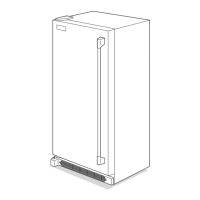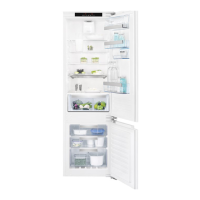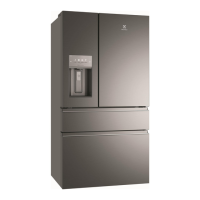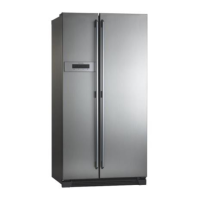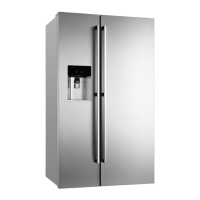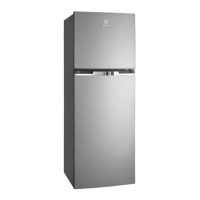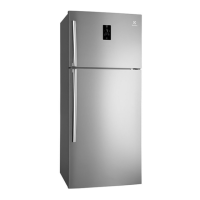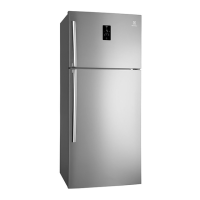Do you have a question about the Electrolux E32AR85PQS and is the answer not in the manual?
Section to record purchase date, model number, and serial number for quick reference.
Information on registering your product online or via mail for enhanced service.
Provides toll-free telephone numbers and website for customer support and product information.
Details safety precautions, definitions for DANGER, WARNING, CAUTION, and IMPORTANT symbols.
Provides essential safety instructions for using the refrigerator, including warnings about flammable liquids and moving parts.
Instructions on handling packing materials and preventing child entrapment or suffocation.
Recommends responsible recycling and provides steps for safe disposal of old appliances.
Guidelines for safe electrical connections, grounding, and handling the power cord.
Overview of the refrigerator's features and terminology with an illustrative diagram.
Lists the necessary tools for installing the refrigerator, including wrenches and screwdrivers.
Guidance on selecting a suitable location considering electrical outlets, heat sources, and floor stability.
Step-by-step guide for attaching the door handles to the refrigerator doors.
Instructions on how to remove the toe grille using a screwdriver.
Ensures the refrigerator rests firmly on a solid floor and is level for proper door sealing and cooling.
Detailed steps for leveling the unit using leg levelers and a carpenter's level.
Instructions for leveling when installing two units side-by-side.
How to adjust the lower hinge to fine-tune door height and cabinet spacing.
Adjusting doors side-to-side using slotted hinges for alignment.
Using the lower hinge to adjust door height and align them for paired units.
Step-by-step instructions for safely removing and replacing refrigerator doors.
Guide to understanding and adjusting temperature settings on the electronic control panel.
Information on the initial continuous operation period for the appliance to cool down.
Explains features like 'Replace Air Filter' indicator, Control Lock, and Power Fail indicator.
How the 'REPLACE AIR FILTER' LED works and how to reset the filter timer.
Instructions on how to enable and disable the control panel lock feature.
Explains the POWER FAIL indicator and how it shows temperature deviations due to power outages.
Details the conditions that trigger alarm tones, such as high temperature.
Describes the HIGH TEMP LED and audible alarm when cabinet temperature exceeds 55°F (13°C).
Alerts when the door is open for an extended period, potentially affecting temperature.
Indicates a problem with a temperature sensor, displaying error codes like 'E8' or 'E9'.
Signals when a control panel key is pressed for too long, displaying error codes like 'E7'.
Instructions for initiating, canceling, and understanding the limitations of Sabbath Mode.
Details on the air filter location, replacement frequency, and part number for odor control.
Step-by-step guide for opening the cover, replacing the old filter, and installing a new one.
Explanation of the interior cabinet lighting that gradually ramps up in intensity.
Instructions for safely replacing a burnt-out LED light bulb.
Details on multi-position adjustable slide-out glass shelves for flexible storage.
Steps for lifting, pulling out, and re-inserting shelves into wall brackets and slots.
Information on the Cool Zone™™ Drawer for storing deli items like meats, spreads, and cheeses.
Guide to using the crisper drawer for fruits and vegetables, including humidity control and divider adjustment.
Instructions for removing the glass cover and then lifting out the drawers.
Details on adjustable door bins that can be moved to suit individual storage needs.
Steps for lifting, removing, placing, and locking door bins into desired positions.
Guidance on using the dairy compartment for short-term storage of dairy products.
Information on door storage designed for gallon containers and other items.
Details on the condiment shelf for storing small items like mustards, jellies, and small jars.
Recommendations for storing fresh food, fruits, vegetables, and meat for optimal quality.
Optimal temperature range for the fresh food compartment (34°F-40°F) and avoiding overcrowding.
Tips for storing produce in crisper drawers to preserve quality using trapped moisture.
Guidelines for securely wrapping raw meat and poultry to prevent leakage and contamination.
Advice on locating the unit, reducing door openings, and maintaining efficiency for lower energy use.
Guidance for leaving the appliance during short or long vacations, and tips for moving the unit.
Instructions for keeping the unit clean, preventing odors, and general cleaning advice.
Specific cleaning agents and tips for interior, door gaskets, drawers, shelves, toe grille, and exterior.
Use soap and water or baking soda solution for cleaning interior surfaces.
Wipe gaskets with a clean soft cloth to ensure a proper seal.
Clean drawer runners and tracks with a soft cloth. Do not wash removable items in dishwasher.
Use mild liquid sprays or glass cleaner. Allow glass to warm before cleaning.
Remove toe grille and vacuum both sides, then wipe with a sudsy cloth.
Use soap and water or non-abrasive cleaners for exterior surfaces and handles.
Specific instructions for cleaning stainless steel surfaces, avoiding chlorides and bleach.
Guide to diagnosing and resolving common operational problems with the refrigerator.
Potential causes and solutions for when the appliance does not run, including power and control settings.
Reasons why the appliance might run too much, such as ambient temperature or door usage.
Troubleshooting steps for an interior that is too cold, involving temperature control settings.
Solutions for an interior that is too warm, including temperature settings and door seal checks.
Explanation for the 'LO' display, typically indicating the control lock is engaged.
Troubleshooting error codes related to temperature sensors or control issues.
Explanation for the 'Sb' display, indicating the appliance is in Sabbath Mode.
Information about normal operating sounds such as compressor noise, popping, bubbling, and vibrating.
Explanation that modern appliances may have louder sounds due to increased capacity and heavy-duty compressors.
Normal sounds associated with the compressor operating at higher pressures during the ON cycle.
Normal sounds from metal parts expanding and contracting due to temperature changes.
Normal sounds from refrigerant circulating throughout the system.
Addresses causes like uneven leveling or the appliance touching the wall.
Explains normal moisture formation due to weather and improper door sealing.
Discusses normal moisture buildup from hot/humid weather and issues like slightly open doors.
Tips for preventing and removing odors, including cleaning and proper food storage.
Advice on cleaning the interior, replacing air filters, and covering foods with strong odors.
Solutions for doors that do not close properly, often related to leveling or floor stability.
Addresses causes like appliance leveling, floor unevenness, or cabinet misalignment.
Solutions for problems related to the interior light bulb or LED not working.
Steps to resolve issues with the interior light, including checking the bulb, power, and Sabbath mode.
Details the warranty period, what is covered, and consumer responsibilities.
Covers parts and labor for one year from the purchase date, excluding filter cartridges.
Covers cabinet liner and sealed refrigeration system for the second through fifth years.
Specific warranty provisions applicable to customers in the state of Alaska.
Lists consumer responsibilities, including proper installation, use, and basic maintenance.
Details items and damages not covered by the warranty, such as incidental damages and misuse.
Instructions on what to do if service is required, including keeping records and contacting support.
Section to record purchase date, model number, and serial number for quick reference.
Information on registering your product online or via mail for enhanced service.
Provides toll-free telephone numbers and website for customer support and product information.
Details safety precautions, definitions for DANGER, WARNING, CAUTION, and IMPORTANT symbols.
Provides essential safety instructions for using the refrigerator, including warnings about flammable liquids and moving parts.
Instructions on handling packing materials and preventing child entrapment or suffocation.
Recommends responsible recycling and provides steps for safe disposal of old appliances.
Guidelines for safe electrical connections, grounding, and handling the power cord.
Overview of the refrigerator's features and terminology with an illustrative diagram.
Lists the necessary tools for installing the refrigerator, including wrenches and screwdrivers.
Guidance on selecting a suitable location considering electrical outlets, heat sources, and floor stability.
Step-by-step guide for attaching the door handles to the refrigerator doors.
Instructions on how to remove the toe grille using a screwdriver.
Ensures the refrigerator rests firmly on a solid floor and is level for proper door sealing and cooling.
Detailed steps for leveling the unit using leg levelers and a carpenter's level.
Instructions for leveling when installing two units side-by-side.
How to adjust the lower hinge to fine-tune door height and cabinet spacing.
Adjusting doors side-to-side using slotted hinges for alignment.
Using the lower hinge to adjust door height and align them for paired units.
Step-by-step instructions for safely removing and replacing refrigerator doors.
Guide to understanding and adjusting temperature settings on the electronic control panel.
Information on the initial continuous operation period for the appliance to cool down.
Explains features like 'Replace Air Filter' indicator, Control Lock, and Power Fail indicator.
How the 'REPLACE AIR FILTER' LED works and how to reset the filter timer.
Instructions on how to enable and disable the control panel lock feature.
Explains the POWER FAIL indicator and how it shows temperature deviations due to power outages.
Details the conditions that trigger alarm tones, such as high temperature.
Describes the HIGH TEMP LED and audible alarm when cabinet temperature exceeds 55°F (13°C).
Alerts when the door is open for an extended period, potentially affecting temperature.
Indicates a problem with a temperature sensor, displaying error codes like 'E8' or 'E9'.
Signals when a control panel key is pressed for too long, displaying error codes like 'E7'.
Instructions for initiating, canceling, and understanding the limitations of Sabbath Mode.
Details on the air filter location, replacement frequency, and part number for odor control.
Step-by-step guide for opening the cover, replacing the old filter, and installing a new one.
Explanation of the interior cabinet lighting that gradually ramps up in intensity.
Instructions for safely replacing a burnt-out LED light bulb.
Details on multi-position adjustable slide-out glass shelves for flexible storage.
Steps for lifting, pulling out, and re-inserting shelves into wall brackets and slots.
Information on the Cool Zone™™ Drawer for storing deli items like meats, spreads, and cheeses.
Guide to using the crisper drawer for fruits and vegetables, including humidity control and divider adjustment.
Instructions for removing the glass cover and then lifting out the drawers.
Details on adjustable door bins that can be moved to suit individual storage needs.
Steps for lifting, removing, placing, and locking door bins into desired positions.
Guidance on using the dairy compartment for short-term storage of dairy products.
Information on door storage designed for gallon containers and other items.
Details on the condiment shelf for storing small items like mustards, jellies, and small jars.
Recommendations for storing fresh food, fruits, vegetables, and meat for optimal quality.
Optimal temperature range for the fresh food compartment (34°F-40°F) and avoiding overcrowding.
Tips for storing produce in crisper drawers to preserve quality using trapped moisture.
Guidelines for securely wrapping raw meat and poultry to prevent leakage and contamination.
Advice on locating the unit, reducing door openings, and maintaining efficiency for lower energy use.
Guidance for leaving the appliance during short or long vacations, and tips for moving the unit.
Instructions for keeping the unit clean, preventing odors, and general cleaning advice.
Specific cleaning agents and tips for interior, door gaskets, drawers, shelves, toe grille, and exterior.
Use soap and water or baking soda solution for cleaning interior surfaces.
Wipe gaskets with a clean soft cloth to ensure a proper seal.
Clean drawer runners and tracks with a soft cloth. Do not wash removable items in dishwasher.
Use mild liquid sprays or glass cleaner. Allow glass to warm before cleaning.
Remove toe grille and vacuum both sides, then wipe with a sudsy cloth.
Use soap and water or non-abrasive cleaners for exterior surfaces and handles.
Specific instructions for cleaning stainless steel surfaces, avoiding chlorides and bleach.
Guide to diagnosing and resolving common operational problems with the refrigerator.
Potential causes and solutions for when the appliance does not run, including power and control settings.
Reasons why the appliance might run too much, such as ambient temperature or door usage.
Troubleshooting steps for an interior that is too cold, involving temperature control settings.
Solutions for an interior that is too warm, including temperature settings and door seal checks.
Explanation for the 'LO' display, typically indicating the control lock is engaged.
Troubleshooting error codes related to temperature sensors or control issues.
Explanation for the 'Sb' display, indicating the appliance is in Sabbath Mode.
Information about normal operating sounds such as compressor noise, popping, bubbling, and vibrating.
Explanation that modern appliances may have louder sounds due to increased capacity and heavy-duty compressors.
Normal sounds associated with the compressor operating at higher pressures during the ON cycle.
Normal sounds from metal parts expanding and contracting due to temperature changes.
Normal sounds from refrigerant circulating throughout the system.
Addresses causes like uneven leveling or the appliance touching the wall.
Explains normal moisture formation due to weather and improper door sealing.
Discusses normal moisture buildup from hot/humid weather and issues like slightly open doors.
Tips for preventing and removing odors, including cleaning and proper food storage.
Advice on cleaning the interior, replacing air filters, and covering foods with strong odors.
Solutions for doors that do not close properly, often related to leveling or floor stability.
Addresses causes like appliance leveling, floor unevenness, or cabinet misalignment.
Solutions for problems related to the interior light bulb or LED not working.
Steps to resolve issues with the interior light, including checking the bulb, power, and Sabbath mode.
Details the warranty period, what is covered, and consumer responsibilities.
Covers parts and labor for one year from the purchase date, excluding filter cartridges.
Covers cabinet liner and sealed refrigeration system for the second through fifth years.
Specific warranty provisions applicable to customers in the state of Alaska.
Lists consumer responsibilities, including proper installation, use, and basic maintenance.
Details items and damages not covered by the warranty, such as incidental damages and misuse.
Instructions on what to do if service is required, including keeping records and contacting support.
| Type | built-in |
|---|---|
| Style | french door |
| Color | stainless steel |
| Refrigerator Capacity | 18.5 cubic feet |
| Humidity Controlled Crispers | yes |
| Defrost System | automatic |
| Number of Refrigerator Door Bins | yes |
| Temperature Control | digital |
| Interior Light | led |
| Ice Maker | no |
| Water Filter | no |
| Door Alarm | yes |
| Smart Home | no |
| Annual Energy Consumption | 331 kilowatt hours |
| Voltage | 115 volts |
| Current | 20 amperes |
| Depth | 26.5 inches |
|---|---|
| Height | 71.38 inches |
| Width | 32 inches |
| Net Weight | 240 pounds |
